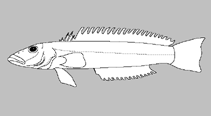Parapercis moki Ho & Johnson, 2013
Mok's sandperch
Upload your photos and videos
Pictures | Google imageNo image available for this species;
drawing shows typical species in Pinguipedidae.
Pictures | Google imageNo image available for this species;
drawing shows typical species in Pinguipedidae.
Common names from other countries
Classification / Names Common names | Synonyms | Catalog of Fishes(genus, species) | ITIS | CoL | WoRMS | Cloffa
Teleostei (teleosts) > Perciformes/Uranoscopoidei (Sand dwellers) > Pinguipedidae (Sandperches)
Etymology: Parapercis: Greek, para = the side of + Greek, perke = perch (Ref. 45335); moki: Named for Professor Hin-Kiu Mok, National Sun Ye-San University.
Etymology: Parapercis: Greek, para = the side of + Greek, perke = perch (Ref. 45335); moki: Named for Professor Hin-Kiu Mok, National Sun Ye-San University.
Environment: milieu / climate zone / depth range / distribution range Ecology
Marine; demersal; depth range ? - 100 m (Ref. 93085). Subtropical
Distribution Countries | FAO areas | Ecosystems | Occurrences | Point map | Introductions | Faunafri
Northwest Pacific: Taiwan.
Size / Weight / Age
Short description Identification keys | Morphology | Morphometrics
Dorsal spines (total): 4; Dorsal soft rays (total): 23; Anal spines: 1; Anal soft rays: 19; Vertebrae: 32 - 33. This species is distinguished by the following characters: with a band across head, body with six transverse bands and blade-like bar below eye; numerous small pores connected by canals forming about 9-10 vertical rows on cheek, opercle, and subopercle; scales on nape extending anteriorly to the level of posterior margin of eyes; large spine on posteroventral corner of subopercle; a very narrow interorbital space (1.7?2.0% SL); D IV, each spine progressively
longer, last spine entirely connected by membrane to first dorsal-fin ray; canine teeth 4 pairs, anteriorly in lower jaw; palatine teeth in two rows; vomerine teeth stout, in two rows (Ref. 127987).
Most likely to occur in shallow waters not exceeding 100 m (Ref. 127987).
Life cycle and mating behavior Maturity | Reproduction | Spawning | Eggs | Fecundity | Larvae
Main reference
Upload your references | References | Coordinator : Ho, Hsuan-Ching | Collaborators
Ho, H.-C. and J.W. Johnson, 2013. Redescription of Parapercis macrophthalma (Pietschmann, 1911) and description of a new species of Parapercis (Pisces: Pinguipedidae) from Taiwan. Zootaxa 3620(2):273-282. (Ref. 93085)
Threat to humans
Harmless
Human uses
FAO(Publication : search) | FishSource |
More information
Trophic ecology
Food items
Diet composition
Food consumption
Food rations
Predators
Food items
Diet composition
Food consumption
Food rations
Predators
Ecology
Ecology
Home ranges
Ecology
Home ranges
Population dynamics
Growth parameters
Max. ages / sizes
Length-weight rel.
Length-length rel.
Length-frequencies
Mass conversion
Recruitment
Abundance
Growth parameters
Max. ages / sizes
Length-weight rel.
Length-length rel.
Length-frequencies
Mass conversion
Recruitment
Abundance
Life cycle
Reproduction
Maturity
Fecundity
Spawning
Spawning aggregations
Eggs
Egg development
Larvae
Larval dynamics
Reproduction
Maturity
Fecundity
Spawning
Spawning aggregations
Eggs
Egg development
Larvae
Larval dynamics
Anatomy
Gill area
Brain
Otolith
Gill area
Brain
Otolith
Physiology
Body composition
Nutrients
Oxygen consumption
Swimming type
Swimming speed
Visual pigments
Fish sound
Diseases & Parasites
Toxicity (LC50s)
Body composition
Nutrients
Oxygen consumption
Swimming type
Swimming speed
Visual pigments
Fish sound
Diseases & Parasites
Toxicity (LC50s)
Genetics
Genetics
Heterozygosity
Heritability
Genetics
Heterozygosity
Heritability
Human related
Aquaculture systems
Aquaculture profiles
Strains
Ciguatera cases
Stamps, coins, misc.
Aquaculture systems
Aquaculture profiles
Strains
Ciguatera cases
Stamps, coins, misc.
Tools
E-book | Field guide | Length-frequency wizard | Life-history tool | Point map | Classification Tree
| Catch-MSY |
Special reports
Download XML
Internet sources
Aquatic Commons | BHL | Cloffa | Websites from users | Check FishWatcher | CISTI | Catalog of Fishes(genus, species) | DiscoverLife | ECOTOX | Faunafri | Fishtrace | GenBank(genome, nucleotide) | GloBI | GOBASE | | Google Books | Google Scholar | Google | IGFA World Record | MitoFish | National databases | Otolith Atlas of Taiwan Fishes | PubMed | Reef Life Survey | Scirus | SeaLifeBase | Tree of Life | Wikipedia(Go, Search) | World Records Freshwater Fishing | Zoobank | Zoological Record
Estimates based on models
Phylogenetic diversity index (Ref. 82804): PD50 = No PD50 data [Uniqueness, from 0.5 = low to 2.0 = high].
Bayesian length-weight: a=0.00692 (0.00314 - 0.01524), b=3.06 (2.88 - 3.24), in cm Total Length, based on LWR estimates for this Genus-body shape (Ref. 93245).
Trophic level (Ref. 69278): 3.4 ±0.4 se; based on size and trophs of closest relatives
Resilience (Ref. 120179): High, minimum population doubling time less than 15 months (Preliminary K or Fecundity.).
Fishing Vulnerability (Ref. 59153): Low vulnerability (10 of 100).




